Business Strategy Report: Nike's Strategic Analysis and Planning
VerifiedAdded on 2021/08/10
|8
|3734
|183
Report
AI Summary
This report provides a comprehensive analysis of Nike's business strategy, encompassing its mission, vision, goals, and objectives. It delves into strategic planning, including environmental analysis and the use of SWOT and PESTLE analysis techniques. The report examines organizational audits, focusing on Nike's resources, distribution channels, and brand image, as well as external factors impacting the company. It also explores stakeholder analysis, identifying key stakeholder groups and their influence on strategic plans. Furthermore, the report suggests a sustainability-focused strategy for Nike, integrating differentiation and cost-cutting approaches to address environmental concerns and maintain a competitive advantage. The analysis includes market entry strategies and potential for mergers and acquisitions, concluding with a call for sustainable practices within Nike's operations.
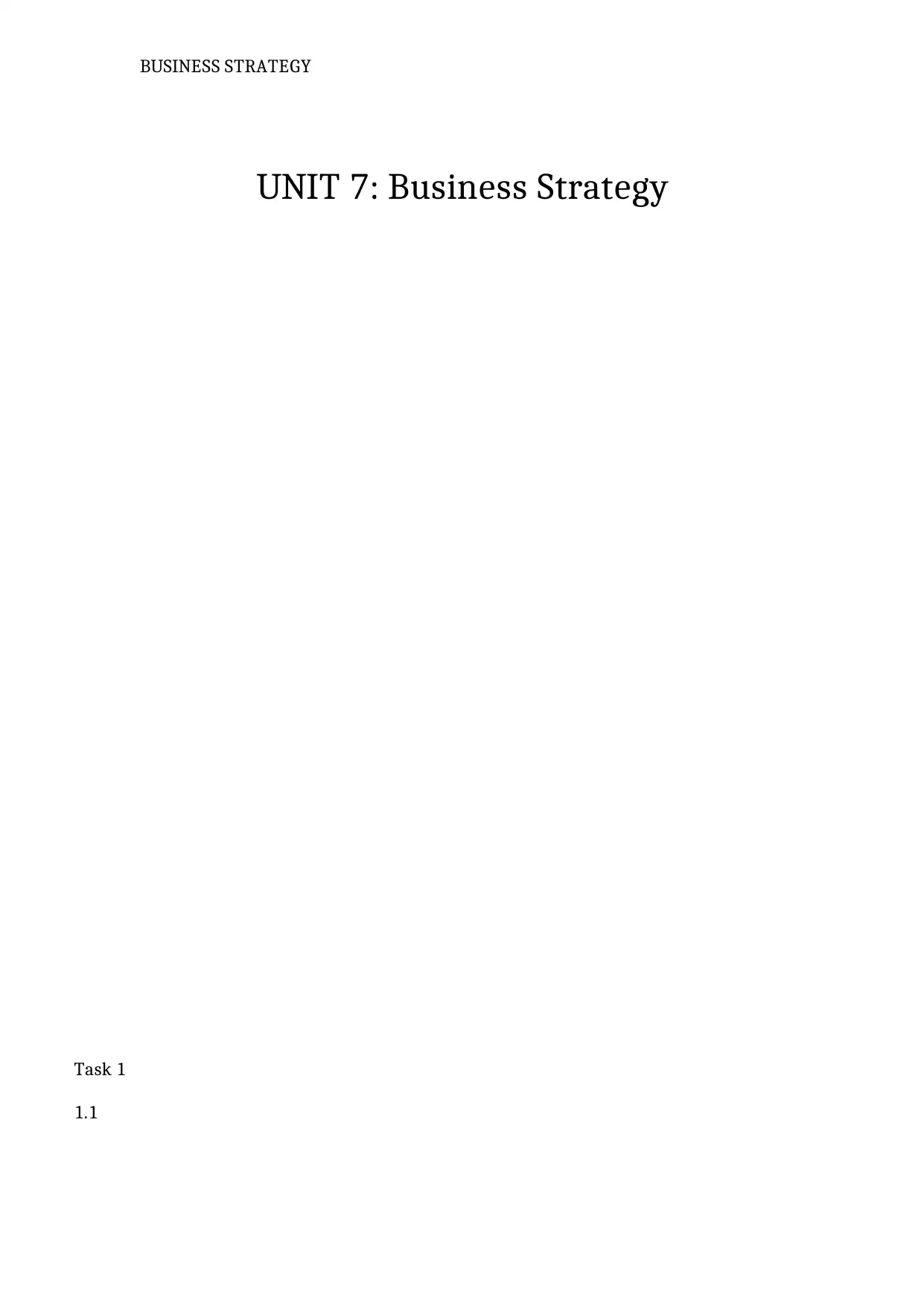
BUSINESS STRATEGY
UNIT 7: Business Strategy
Task 1
1.1
UNIT 7: Business Strategy
Task 1
1.1
Paraphrase This Document
Need a fresh take? Get an instant paraphrase of this document with our AI Paraphraser
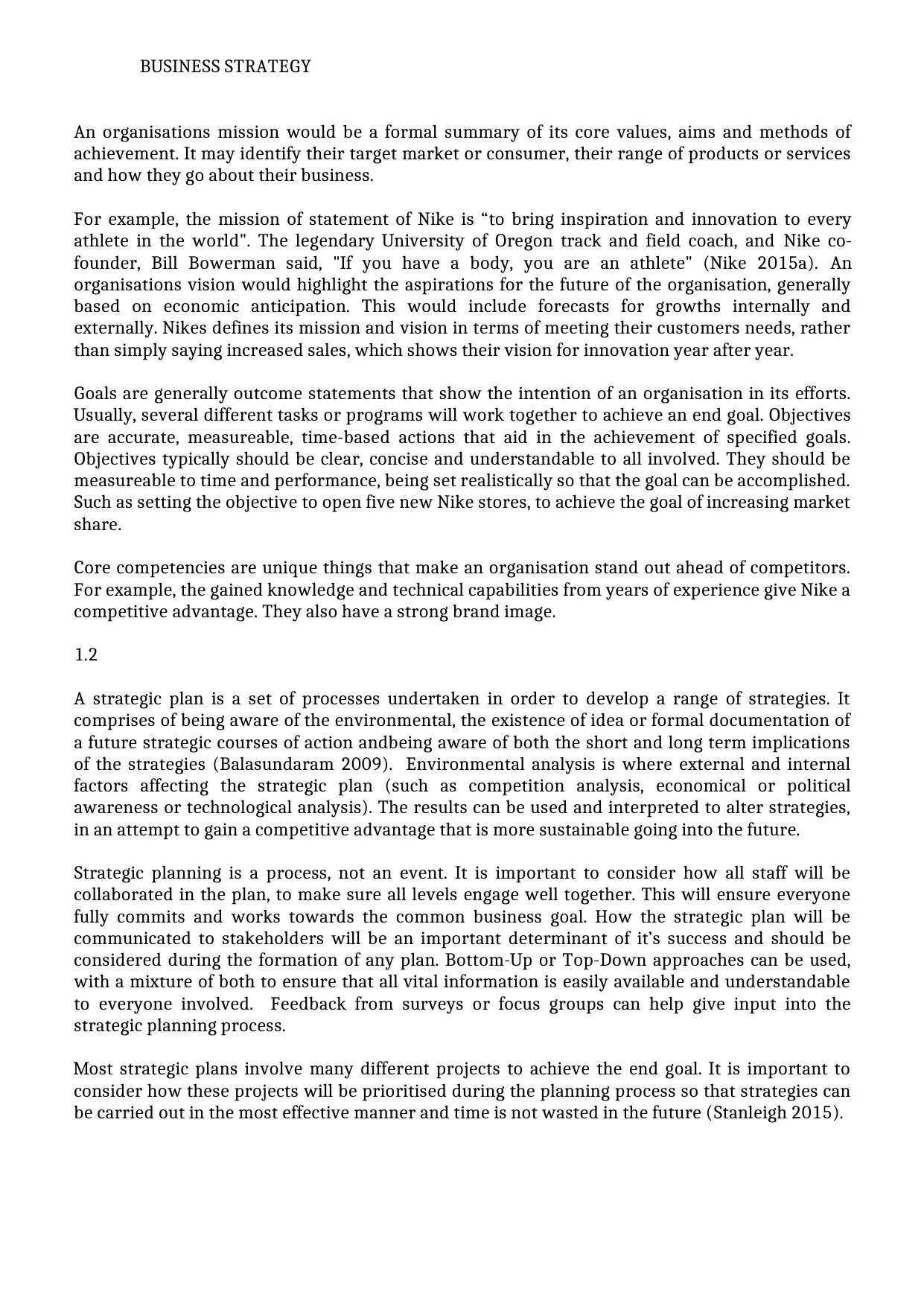
BUSINESS STRATEGY
An organisations mission would be a formal summary of its core values, aims and methods of
achievement. It may identify their target market or consumer, their range of products or services
and how they go about their business.
For example, the mission of statement of Nike is “to bring inspiration and innovation to every
athlete in the world". The legendary University of Oregon track and field coach, and Nike co-
founder, Bill Bowerman said, "If you have a body, you are an athlete" (Nike 2015a). An
organisations vision would highlight the aspirations for the future of the organisation, generally
based on economic anticipation. This would include forecasts for growths internally and
externally. Nikes defines its mission and vision in terms of meeting their customers needs, rather
than simply saying increased sales, which shows their vision for innovation year after year.
Goals are generally outcome statements that show the intention of an organisation in its efforts.
Usually, several different tasks or programs will work together to achieve an end goal. Objectives
are accurate, measureable, time-based actions that aid in the achievement of specified goals.
Objectives typically should be clear, concise and understandable to all involved. They should be
measureable to time and performance, being set realistically so that the goal can be accomplished.
Such as setting the objective to open five new Nike stores, to achieve the goal of increasing market
share.
Core competencies are unique things that make an organisation stand out ahead of competitors.
For example, the gained knowledge and technical capabilities from years of experience give Nike a
competitive advantage. They also have a strong brand image.
1.2
A strategic plan is a set of processes undertaken in order to develop a range of strategies. It
comprises of being aware of the environmental, the existence of idea or formal documentation of
a future strategic courses of action andbeing aware of both the short and long term implications
of the strategies (Balasundaram 2009). Environmental analysis is where external and internal
factors affecting the strategic plan (such as competition analysis, economical or political
awareness or technological analysis). The results can be used and interpreted to alter strategies,
in an attempt to gain a competitive advantage that is more sustainable going into the future.
Strategic planning is a process, not an event. It is important to consider how all staff will be
collaborated in the plan, to make sure all levels engage well together. This will ensure everyone
fully commits and works towards the common business goal. How the strategic plan will be
communicated to stakeholders will be an important determinant of it’s success and should be
considered during the formation of any plan. Bottom-Up or Top-Down approaches can be used,
with a mixture of both to ensure that all vital information is easily available and understandable
to everyone involved. Feedback from surveys or focus groups can help give input into the
strategic planning process.
Most strategic plans involve many different projects to achieve the end goal. It is important to
consider how these projects will be prioritised during the planning process so that strategies can
be carried out in the most effective manner and time is not wasted in the future (Stanleigh 2015).
An organisations mission would be a formal summary of its core values, aims and methods of
achievement. It may identify their target market or consumer, their range of products or services
and how they go about their business.
For example, the mission of statement of Nike is “to bring inspiration and innovation to every
athlete in the world". The legendary University of Oregon track and field coach, and Nike co-
founder, Bill Bowerman said, "If you have a body, you are an athlete" (Nike 2015a). An
organisations vision would highlight the aspirations for the future of the organisation, generally
based on economic anticipation. This would include forecasts for growths internally and
externally. Nikes defines its mission and vision in terms of meeting their customers needs, rather
than simply saying increased sales, which shows their vision for innovation year after year.
Goals are generally outcome statements that show the intention of an organisation in its efforts.
Usually, several different tasks or programs will work together to achieve an end goal. Objectives
are accurate, measureable, time-based actions that aid in the achievement of specified goals.
Objectives typically should be clear, concise and understandable to all involved. They should be
measureable to time and performance, being set realistically so that the goal can be accomplished.
Such as setting the objective to open five new Nike stores, to achieve the goal of increasing market
share.
Core competencies are unique things that make an organisation stand out ahead of competitors.
For example, the gained knowledge and technical capabilities from years of experience give Nike a
competitive advantage. They also have a strong brand image.
1.2
A strategic plan is a set of processes undertaken in order to develop a range of strategies. It
comprises of being aware of the environmental, the existence of idea or formal documentation of
a future strategic courses of action andbeing aware of both the short and long term implications
of the strategies (Balasundaram 2009). Environmental analysis is where external and internal
factors affecting the strategic plan (such as competition analysis, economical or political
awareness or technological analysis). The results can be used and interpreted to alter strategies,
in an attempt to gain a competitive advantage that is more sustainable going into the future.
Strategic planning is a process, not an event. It is important to consider how all staff will be
collaborated in the plan, to make sure all levels engage well together. This will ensure everyone
fully commits and works towards the common business goal. How the strategic plan will be
communicated to stakeholders will be an important determinant of it’s success and should be
considered during the formation of any plan. Bottom-Up or Top-Down approaches can be used,
with a mixture of both to ensure that all vital information is easily available and understandable
to everyone involved. Feedback from surveys or focus groups can help give input into the
strategic planning process.
Most strategic plans involve many different projects to achieve the end goal. It is important to
consider how these projects will be prioritised during the planning process so that strategies can
be carried out in the most effective manner and time is not wasted in the future (Stanleigh 2015).
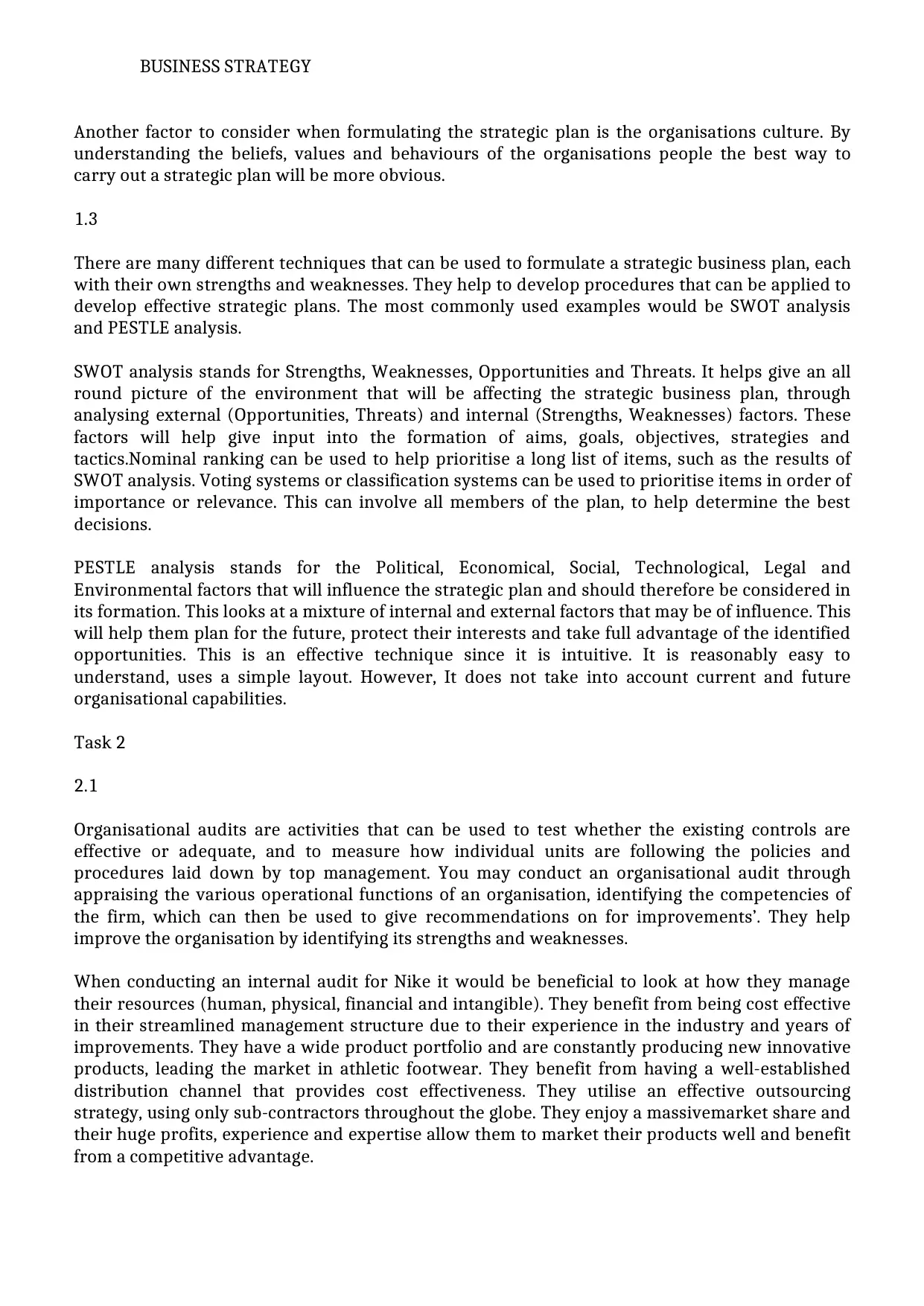
BUSINESS STRATEGY
Another factor to consider when formulating the strategic plan is the organisations culture. By
understanding the beliefs, values and behaviours of the organisations people the best way to
carry out a strategic plan will be more obvious.
1.3
There are many different techniques that can be used to formulate a strategic business plan, each
with their own strengths and weaknesses. They help to develop procedures that can be applied to
develop effective strategic plans. The most commonly used examples would be SWOT analysis
and PESTLE analysis.
SWOT analysis stands for Strengths, Weaknesses, Opportunities and Threats. It helps give an all
round picture of the environment that will be affecting the strategic business plan, through
analysing external (Opportunities, Threats) and internal (Strengths, Weaknesses) factors. These
factors will help give input into the formation of aims, goals, objectives, strategies and
tactics.Nominal ranking can be used to help prioritise a long list of items, such as the results of
SWOT analysis. Voting systems or classification systems can be used to prioritise items in order of
importance or relevance. This can involve all members of the plan, to help determine the best
decisions.
PESTLE analysis stands for the Political, Economical, Social, Technological, Legal and
Environmental factors that will influence the strategic plan and should therefore be considered in
its formation. This looks at a mixture of internal and external factors that may be of influence. This
will help them plan for the future, protect their interests and take full advantage of the identified
opportunities. This is an effective technique since it is intuitive. It is reasonably easy to
understand, uses a simple layout. However, It does not take into account current and future
organisational capabilities.
Task 2
2.1
Organisational audits are activities that can be used to test whether the existing controls are
effective or adequate, and to measure how individual units are following the policies and
procedures laid down by top management. You may conduct an organisational audit through
appraising the various operational functions of an organisation, identifying the competencies of
the firm, which can then be used to give recommendations on for improvements’. They help
improve the organisation by identifying its strengths and weaknesses.
When conducting an internal audit for Nike it would be beneficial to look at how they manage
their resources (human, physical, financial and intangible). They benefit from being cost effective
in their streamlined management structure due to their experience in the industry and years of
improvements. They have a wide product portfolio and are constantly producing new innovative
products, leading the market in athletic footwear. They benefit from having a well-established
distribution channel that provides cost effectiveness. They utilise an effective outsourcing
strategy, using only sub-contractors throughout the globe. They enjoy a massivemarket share and
their huge profits, experience and expertise allow them to market their products well and benefit
from a competitive advantage.
Another factor to consider when formulating the strategic plan is the organisations culture. By
understanding the beliefs, values and behaviours of the organisations people the best way to
carry out a strategic plan will be more obvious.
1.3
There are many different techniques that can be used to formulate a strategic business plan, each
with their own strengths and weaknesses. They help to develop procedures that can be applied to
develop effective strategic plans. The most commonly used examples would be SWOT analysis
and PESTLE analysis.
SWOT analysis stands for Strengths, Weaknesses, Opportunities and Threats. It helps give an all
round picture of the environment that will be affecting the strategic business plan, through
analysing external (Opportunities, Threats) and internal (Strengths, Weaknesses) factors. These
factors will help give input into the formation of aims, goals, objectives, strategies and
tactics.Nominal ranking can be used to help prioritise a long list of items, such as the results of
SWOT analysis. Voting systems or classification systems can be used to prioritise items in order of
importance or relevance. This can involve all members of the plan, to help determine the best
decisions.
PESTLE analysis stands for the Political, Economical, Social, Technological, Legal and
Environmental factors that will influence the strategic plan and should therefore be considered in
its formation. This looks at a mixture of internal and external factors that may be of influence. This
will help them plan for the future, protect their interests and take full advantage of the identified
opportunities. This is an effective technique since it is intuitive. It is reasonably easy to
understand, uses a simple layout. However, It does not take into account current and future
organisational capabilities.
Task 2
2.1
Organisational audits are activities that can be used to test whether the existing controls are
effective or adequate, and to measure how individual units are following the policies and
procedures laid down by top management. You may conduct an organisational audit through
appraising the various operational functions of an organisation, identifying the competencies of
the firm, which can then be used to give recommendations on for improvements’. They help
improve the organisation by identifying its strengths and weaknesses.
When conducting an internal audit for Nike it would be beneficial to look at how they manage
their resources (human, physical, financial and intangible). They benefit from being cost effective
in their streamlined management structure due to their experience in the industry and years of
improvements. They have a wide product portfolio and are constantly producing new innovative
products, leading the market in athletic footwear. They benefit from having a well-established
distribution channel that provides cost effectiveness. They utilise an effective outsourcing
strategy, using only sub-contractors throughout the globe. They enjoy a massivemarket share and
their huge profits, experience and expertise allow them to market their products well and benefit
from a competitive advantage.
⊘ This is a preview!⊘
Do you want full access?
Subscribe today to unlock all pages.

Trusted by 1+ million students worldwide
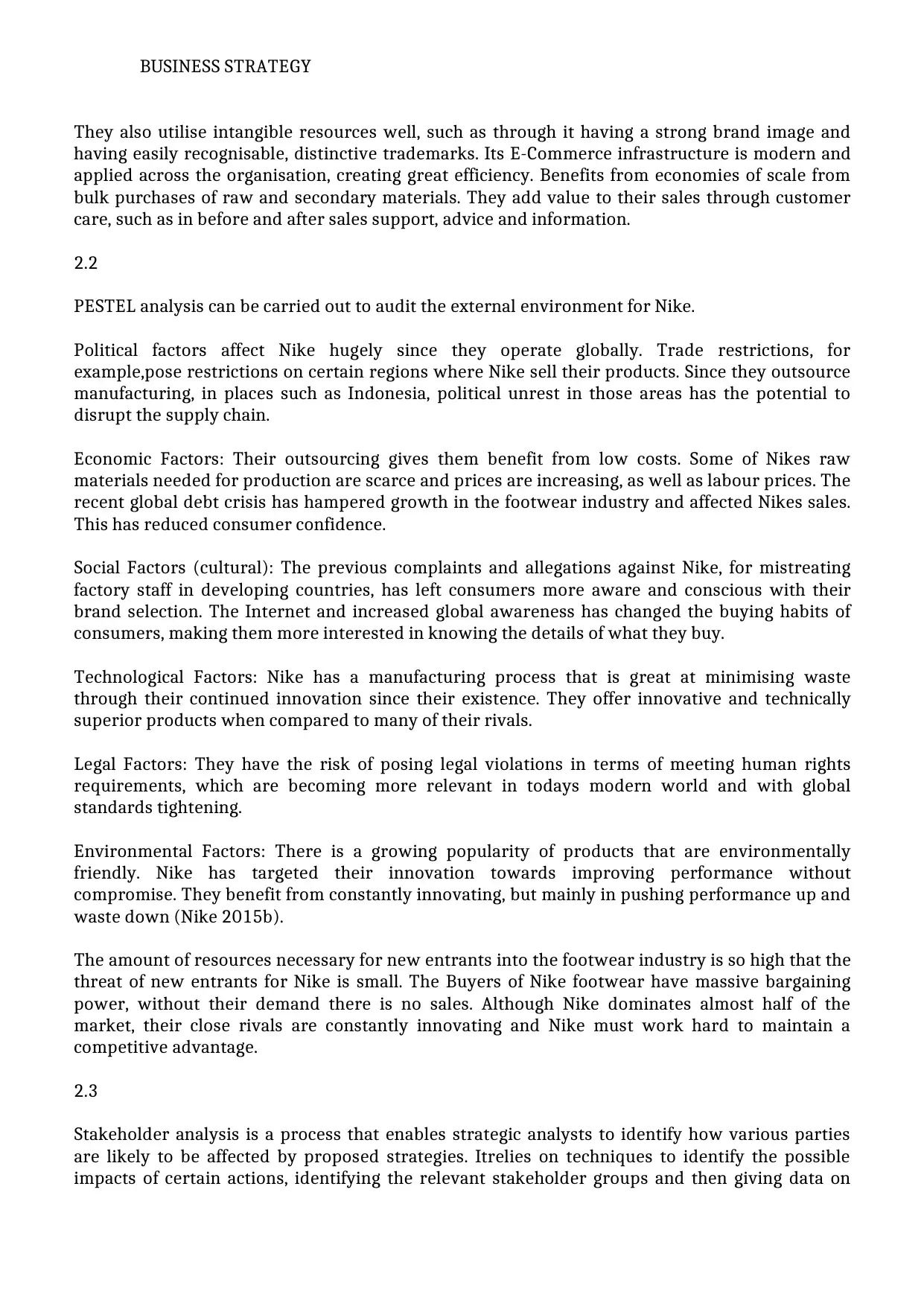
BUSINESS STRATEGY
They also utilise intangible resources well, such as through it having a strong brand image and
having easily recognisable, distinctive trademarks. Its E-Commerce infrastructure is modern and
applied across the organisation, creating great efficiency. Benefits from economies of scale from
bulk purchases of raw and secondary materials. They add value to their sales through customer
care, such as in before and after sales support, advice and information.
2.2
PESTEL analysis can be carried out to audit the external environment for Nike.
Political factors affect Nike hugely since they operate globally. Trade restrictions, for
example,pose restrictions on certain regions where Nike sell their products. Since they outsource
manufacturing, in places such as Indonesia, political unrest in those areas has the potential to
disrupt the supply chain.
Economic Factors: Their outsourcing gives them benefit from low costs. Some of Nikes raw
materials needed for production are scarce and prices are increasing, as well as labour prices. The
recent global debt crisis has hampered growth in the footwear industry and affected Nikes sales.
This has reduced consumer confidence.
Social Factors (cultural): The previous complaints and allegations against Nike, for mistreating
factory staff in developing countries, has left consumers more aware and conscious with their
brand selection. The Internet and increased global awareness has changed the buying habits of
consumers, making them more interested in knowing the details of what they buy.
Technological Factors: Nike has a manufacturing process that is great at minimising waste
through their continued innovation since their existence. They offer innovative and technically
superior products when compared to many of their rivals.
Legal Factors: They have the risk of posing legal violations in terms of meeting human rights
requirements, which are becoming more relevant in todays modern world and with global
standards tightening.
Environmental Factors: There is a growing popularity of products that are environmentally
friendly. Nike has targeted their innovation towards improving performance without
compromise. They benefit from constantly innovating, but mainly in pushing performance up and
waste down (Nike 2015b).
The amount of resources necessary for new entrants into the footwear industry is so high that the
threat of new entrants for Nike is small. The Buyers of Nike footwear have massive bargaining
power, without their demand there is no sales. Although Nike dominates almost half of the
market, their close rivals are constantly innovating and Nike must work hard to maintain a
competitive advantage.
2.3
Stakeholder analysis is a process that enables strategic analysts to identify how various parties
are likely to be affected by proposed strategies. Itrelies on techniques to identify the possible
impacts of certain actions, identifying the relevant stakeholder groups and then giving data on
They also utilise intangible resources well, such as through it having a strong brand image and
having easily recognisable, distinctive trademarks. Its E-Commerce infrastructure is modern and
applied across the organisation, creating great efficiency. Benefits from economies of scale from
bulk purchases of raw and secondary materials. They add value to their sales through customer
care, such as in before and after sales support, advice and information.
2.2
PESTEL analysis can be carried out to audit the external environment for Nike.
Political factors affect Nike hugely since they operate globally. Trade restrictions, for
example,pose restrictions on certain regions where Nike sell their products. Since they outsource
manufacturing, in places such as Indonesia, political unrest in those areas has the potential to
disrupt the supply chain.
Economic Factors: Their outsourcing gives them benefit from low costs. Some of Nikes raw
materials needed for production are scarce and prices are increasing, as well as labour prices. The
recent global debt crisis has hampered growth in the footwear industry and affected Nikes sales.
This has reduced consumer confidence.
Social Factors (cultural): The previous complaints and allegations against Nike, for mistreating
factory staff in developing countries, has left consumers more aware and conscious with their
brand selection. The Internet and increased global awareness has changed the buying habits of
consumers, making them more interested in knowing the details of what they buy.
Technological Factors: Nike has a manufacturing process that is great at minimising waste
through their continued innovation since their existence. They offer innovative and technically
superior products when compared to many of their rivals.
Legal Factors: They have the risk of posing legal violations in terms of meeting human rights
requirements, which are becoming more relevant in todays modern world and with global
standards tightening.
Environmental Factors: There is a growing popularity of products that are environmentally
friendly. Nike has targeted their innovation towards improving performance without
compromise. They benefit from constantly innovating, but mainly in pushing performance up and
waste down (Nike 2015b).
The amount of resources necessary for new entrants into the footwear industry is so high that the
threat of new entrants for Nike is small. The Buyers of Nike footwear have massive bargaining
power, without their demand there is no sales. Although Nike dominates almost half of the
market, their close rivals are constantly innovating and Nike must work hard to maintain a
competitive advantage.
2.3
Stakeholder analysis is a process that enables strategic analysts to identify how various parties
are likely to be affected by proposed strategies. Itrelies on techniques to identify the possible
impacts of certain actions, identifying the relevant stakeholder groups and then giving data on
Paraphrase This Document
Need a fresh take? Get an instant paraphrase of this document with our AI Paraphraser
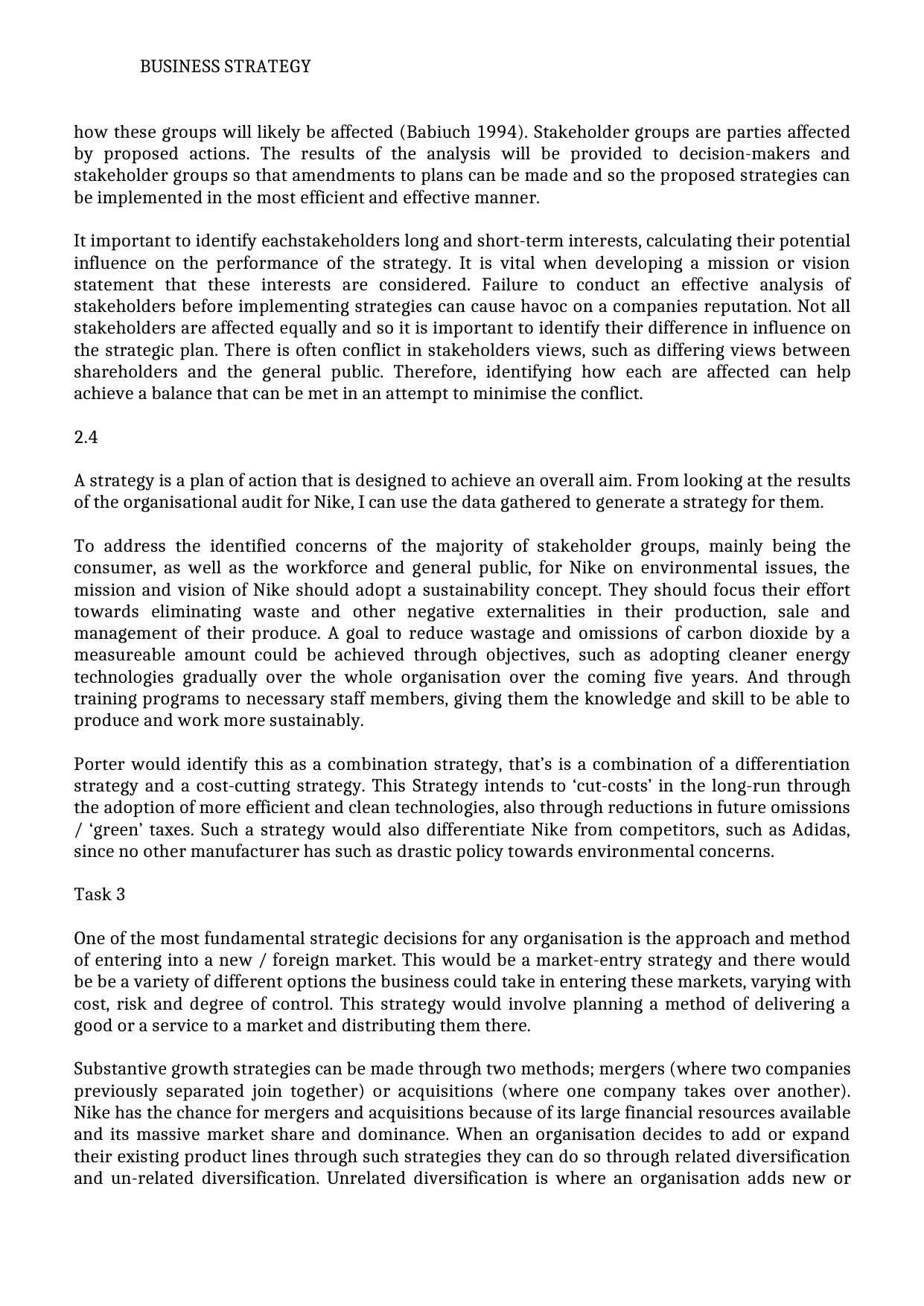
BUSINESS STRATEGY
how these groups will likely be affected (Babiuch 1994). Stakeholder groups are parties affected
by proposed actions. The results of the analysis will be provided to decision-makers and
stakeholder groups so that amendments to plans can be made and so the proposed strategies can
be implemented in the most efficient and effective manner.
It important to identify eachstakeholders long and short-term interests, calculating their potential
influence on the performance of the strategy. It is vital when developing a mission or vision
statement that these interests are considered. Failure to conduct an effective analysis of
stakeholders before implementing strategies can cause havoc on a companies reputation. Not all
stakeholders are affected equally and so it is important to identify their difference in influence on
the strategic plan. There is often conflict in stakeholders views, such as differing views between
shareholders and the general public. Therefore, identifying how each are affected can help
achieve a balance that can be met in an attempt to minimise the conflict.
2.4
A strategy is a plan of action that is designed to achieve an overall aim. From looking at the results
of the organisational audit for Nike, I can use the data gathered to generate a strategy for them.
To address the identified concerns of the majority of stakeholder groups, mainly being the
consumer, as well as the workforce and general public, for Nike on environmental issues, the
mission and vision of Nike should adopt a sustainability concept. They should focus their effort
towards eliminating waste and other negative externalities in their production, sale and
management of their produce. A goal to reduce wastage and omissions of carbon dioxide by a
measureable amount could be achieved through objectives, such as adopting cleaner energy
technologies gradually over the whole organisation over the coming five years. And through
training programs to necessary staff members, giving them the knowledge and skill to be able to
produce and work more sustainably.
Porter would identify this as a combination strategy, that’s is a combination of a differentiation
strategy and a cost-cutting strategy. This Strategy intends to ‘cut-costs’ in the long-run through
the adoption of more efficient and clean technologies, also through reductions in future omissions
/ ‘green’ taxes. Such a strategy would also differentiate Nike from competitors, such as Adidas,
since no other manufacturer has such as drastic policy towards environmental concerns.
Task 3
One of the most fundamental strategic decisions for any organisation is the approach and method
of entering into a new / foreign market. This would be a market-entry strategy and there would
be be a variety of different options the business could take in entering these markets, varying with
cost, risk and degree of control. This strategy would involve planning a method of delivering a
good or a service to a market and distributing them there.
Substantive growth strategies can be made through two methods; mergers (where two companies
previously separated join together) or acquisitions (where one company takes over another).
Nike has the chance for mergers and acquisitions because of its large financial resources available
and its massive market share and dominance. When an organisation decides to add or expand
their existing product lines through such strategies they can do so through related diversification
and un-related diversification. Unrelated diversification is where an organisation adds new or
how these groups will likely be affected (Babiuch 1994). Stakeholder groups are parties affected
by proposed actions. The results of the analysis will be provided to decision-makers and
stakeholder groups so that amendments to plans can be made and so the proposed strategies can
be implemented in the most efficient and effective manner.
It important to identify eachstakeholders long and short-term interests, calculating their potential
influence on the performance of the strategy. It is vital when developing a mission or vision
statement that these interests are considered. Failure to conduct an effective analysis of
stakeholders before implementing strategies can cause havoc on a companies reputation. Not all
stakeholders are affected equally and so it is important to identify their difference in influence on
the strategic plan. There is often conflict in stakeholders views, such as differing views between
shareholders and the general public. Therefore, identifying how each are affected can help
achieve a balance that can be met in an attempt to minimise the conflict.
2.4
A strategy is a plan of action that is designed to achieve an overall aim. From looking at the results
of the organisational audit for Nike, I can use the data gathered to generate a strategy for them.
To address the identified concerns of the majority of stakeholder groups, mainly being the
consumer, as well as the workforce and general public, for Nike on environmental issues, the
mission and vision of Nike should adopt a sustainability concept. They should focus their effort
towards eliminating waste and other negative externalities in their production, sale and
management of their produce. A goal to reduce wastage and omissions of carbon dioxide by a
measureable amount could be achieved through objectives, such as adopting cleaner energy
technologies gradually over the whole organisation over the coming five years. And through
training programs to necessary staff members, giving them the knowledge and skill to be able to
produce and work more sustainably.
Porter would identify this as a combination strategy, that’s is a combination of a differentiation
strategy and a cost-cutting strategy. This Strategy intends to ‘cut-costs’ in the long-run through
the adoption of more efficient and clean technologies, also through reductions in future omissions
/ ‘green’ taxes. Such a strategy would also differentiate Nike from competitors, such as Adidas,
since no other manufacturer has such as drastic policy towards environmental concerns.
Task 3
One of the most fundamental strategic decisions for any organisation is the approach and method
of entering into a new / foreign market. This would be a market-entry strategy and there would
be be a variety of different options the business could take in entering these markets, varying with
cost, risk and degree of control. This strategy would involve planning a method of delivering a
good or a service to a market and distributing them there.
Substantive growth strategies can be made through two methods; mergers (where two companies
previously separated join together) or acquisitions (where one company takes over another).
Nike has the chance for mergers and acquisitions because of its large financial resources available
and its massive market share and dominance. When an organisation decides to add or expand
their existing product lines through such strategies they can do so through related diversification
and un-related diversification. Unrelated diversification is where an organisation adds new or
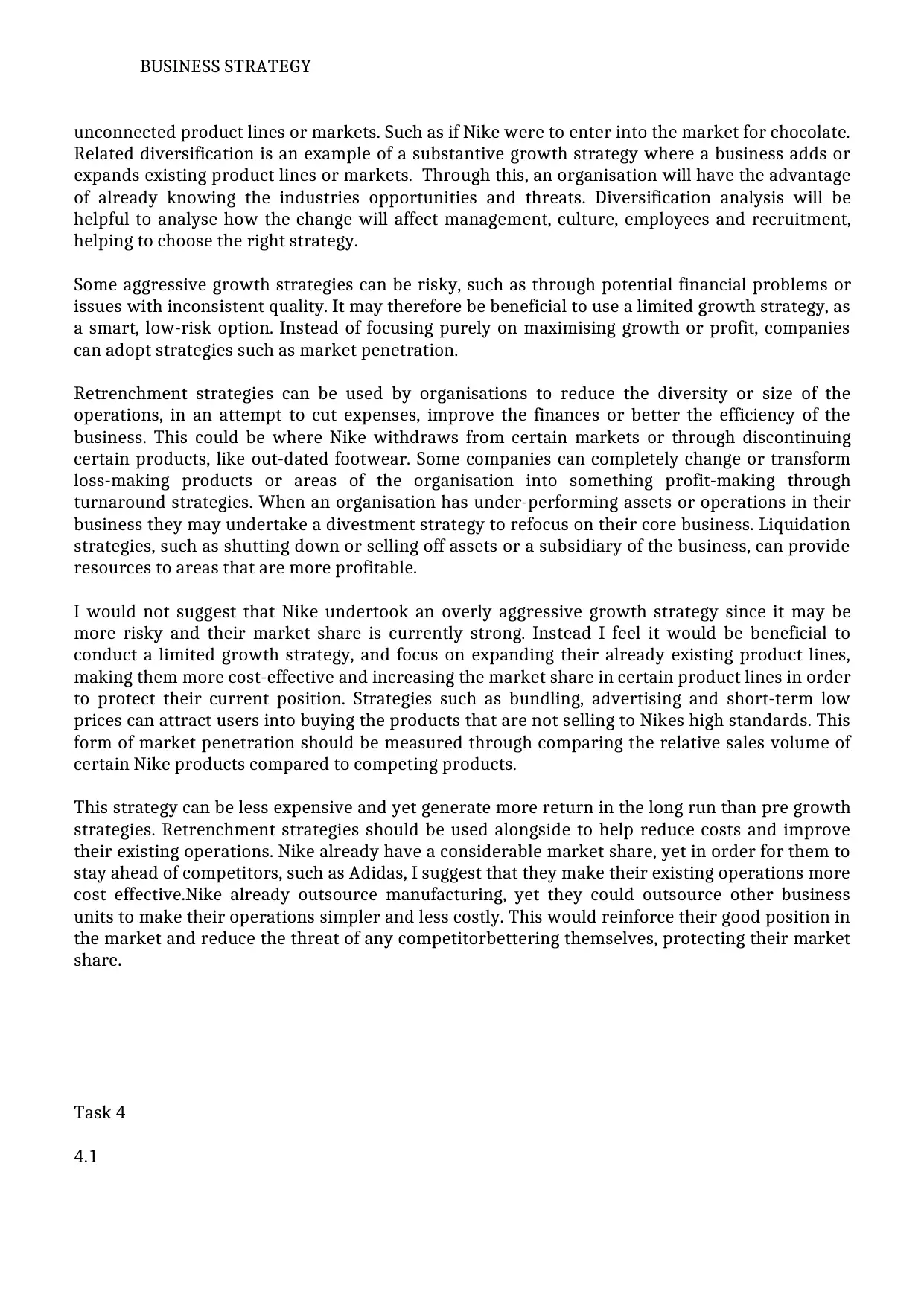
BUSINESS STRATEGY
unconnected product lines or markets. Such as if Nike were to enter into the market for chocolate.
Related diversification is an example of a substantive growth strategy where a business adds or
expands existing product lines or markets. Through this, an organisation will have the advantage
of already knowing the industries opportunities and threats. Diversification analysis will be
helpful to analyse how the change will affect management, culture, employees and recruitment,
helping to choose the right strategy.
Some aggressive growth strategies can be risky, such as through potential financial problems or
issues with inconsistent quality. It may therefore be beneficial to use a limited growth strategy, as
a smart, low-risk option. Instead of focusing purely on maximising growth or profit, companies
can adopt strategies such as market penetration.
Retrenchment strategies can be used by organisations to reduce the diversity or size of the
operations, in an attempt to cut expenses, improve the finances or better the efficiency of the
business. This could be where Nike withdraws from certain markets or through discontinuing
certain products, like out-dated footwear. Some companies can completely change or transform
loss-making products or areas of the organisation into something profit-making through
turnaround strategies. When an organisation has under-performing assets or operations in their
business they may undertake a divestment strategy to refocus on their core business. Liquidation
strategies, such as shutting down or selling off assets or a subsidiary of the business, can provide
resources to areas that are more profitable.
I would not suggest that Nike undertook an overly aggressive growth strategy since it may be
more risky and their market share is currently strong. Instead I feel it would be beneficial to
conduct a limited growth strategy, and focus on expanding their already existing product lines,
making them more cost-effective and increasing the market share in certain product lines in order
to protect their current position. Strategies such as bundling, advertising and short-term low
prices can attract users into buying the products that are not selling to Nikes high standards. This
form of market penetration should be measured through comparing the relative sales volume of
certain Nike products compared to competing products.
This strategy can be less expensive and yet generate more return in the long run than pre growth
strategies. Retrenchment strategies should be used alongside to help reduce costs and improve
their existing operations. Nike already have a considerable market share, yet in order for them to
stay ahead of competitors, such as Adidas, I suggest that they make their existing operations more
cost effective.Nike already outsource manufacturing, yet they could outsource other business
units to make their operations simpler and less costly. This would reinforce their good position in
the market and reduce the threat of any competitorbettering themselves, protecting their market
share.
Task 4
4.1
unconnected product lines or markets. Such as if Nike were to enter into the market for chocolate.
Related diversification is an example of a substantive growth strategy where a business adds or
expands existing product lines or markets. Through this, an organisation will have the advantage
of already knowing the industries opportunities and threats. Diversification analysis will be
helpful to analyse how the change will affect management, culture, employees and recruitment,
helping to choose the right strategy.
Some aggressive growth strategies can be risky, such as through potential financial problems or
issues with inconsistent quality. It may therefore be beneficial to use a limited growth strategy, as
a smart, low-risk option. Instead of focusing purely on maximising growth or profit, companies
can adopt strategies such as market penetration.
Retrenchment strategies can be used by organisations to reduce the diversity or size of the
operations, in an attempt to cut expenses, improve the finances or better the efficiency of the
business. This could be where Nike withdraws from certain markets or through discontinuing
certain products, like out-dated footwear. Some companies can completely change or transform
loss-making products or areas of the organisation into something profit-making through
turnaround strategies. When an organisation has under-performing assets or operations in their
business they may undertake a divestment strategy to refocus on their core business. Liquidation
strategies, such as shutting down or selling off assets or a subsidiary of the business, can provide
resources to areas that are more profitable.
I would not suggest that Nike undertook an overly aggressive growth strategy since it may be
more risky and their market share is currently strong. Instead I feel it would be beneficial to
conduct a limited growth strategy, and focus on expanding their already existing product lines,
making them more cost-effective and increasing the market share in certain product lines in order
to protect their current position. Strategies such as bundling, advertising and short-term low
prices can attract users into buying the products that are not selling to Nikes high standards. This
form of market penetration should be measured through comparing the relative sales volume of
certain Nike products compared to competing products.
This strategy can be less expensive and yet generate more return in the long run than pre growth
strategies. Retrenchment strategies should be used alongside to help reduce costs and improve
their existing operations. Nike already have a considerable market share, yet in order for them to
stay ahead of competitors, such as Adidas, I suggest that they make their existing operations more
cost effective.Nike already outsource manufacturing, yet they could outsource other business
units to make their operations simpler and less costly. This would reinforce their good position in
the market and reduce the threat of any competitorbettering themselves, protecting their market
share.
Task 4
4.1
⊘ This is a preview!⊘
Do you want full access?
Subscribe today to unlock all pages.

Trusted by 1+ million students worldwide
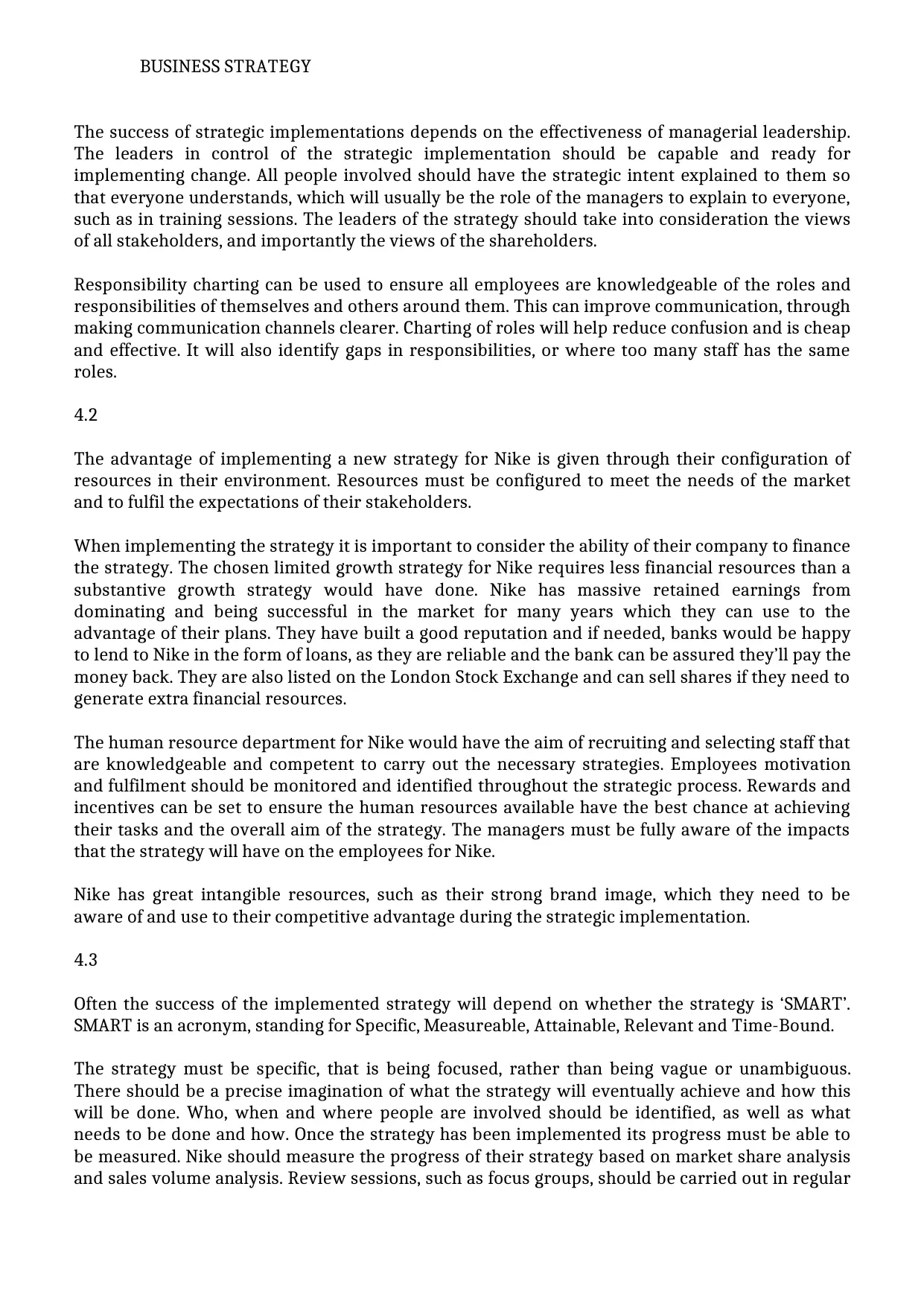
BUSINESS STRATEGY
The success of strategic implementations depends on the effectiveness of managerial leadership.
The leaders in control of the strategic implementation should be capable and ready for
implementing change. All people involved should have the strategic intent explained to them so
that everyone understands, which will usually be the role of the managers to explain to everyone,
such as in training sessions. The leaders of the strategy should take into consideration the views
of all stakeholders, and importantly the views of the shareholders.
Responsibility charting can be used to ensure all employees are knowledgeable of the roles and
responsibilities of themselves and others around them. This can improve communication, through
making communication channels clearer. Charting of roles will help reduce confusion and is cheap
and effective. It will also identify gaps in responsibilities, or where too many staff has the same
roles.
4.2
The advantage of implementing a new strategy for Nike is given through their configuration of
resources in their environment. Resources must be configured to meet the needs of the market
and to fulfil the expectations of their stakeholders.
When implementing the strategy it is important to consider the ability of their company to finance
the strategy. The chosen limited growth strategy for Nike requires less financial resources than a
substantive growth strategy would have done. Nike has massive retained earnings from
dominating and being successful in the market for many years which they can use to the
advantage of their plans. They have built a good reputation and if needed, banks would be happy
to lend to Nike in the form of loans, as they are reliable and the bank can be assured they’ll pay the
money back. They are also listed on the London Stock Exchange and can sell shares if they need to
generate extra financial resources.
The human resource department for Nike would have the aim of recruiting and selecting staff that
are knowledgeable and competent to carry out the necessary strategies. Employees motivation
and fulfilment should be monitored and identified throughout the strategic process. Rewards and
incentives can be set to ensure the human resources available have the best chance at achieving
their tasks and the overall aim of the strategy. The managers must be fully aware of the impacts
that the strategy will have on the employees for Nike.
Nike has great intangible resources, such as their strong brand image, which they need to be
aware of and use to their competitive advantage during the strategic implementation.
4.3
Often the success of the implemented strategy will depend on whether the strategy is ‘SMART’.
SMART is an acronym, standing for Specific, Measureable, Attainable, Relevant and Time-Bound.
The strategy must be specific, that is being focused, rather than being vague or unambiguous.
There should be a precise imagination of what the strategy will eventually achieve and how this
will be done. Who, when and where people are involved should be identified, as well as what
needs to be done and how. Once the strategy has been implemented its progress must be able to
be measured. Nike should measure the progress of their strategy based on market share analysis
and sales volume analysis. Review sessions, such as focus groups, should be carried out in regular
The success of strategic implementations depends on the effectiveness of managerial leadership.
The leaders in control of the strategic implementation should be capable and ready for
implementing change. All people involved should have the strategic intent explained to them so
that everyone understands, which will usually be the role of the managers to explain to everyone,
such as in training sessions. The leaders of the strategy should take into consideration the views
of all stakeholders, and importantly the views of the shareholders.
Responsibility charting can be used to ensure all employees are knowledgeable of the roles and
responsibilities of themselves and others around them. This can improve communication, through
making communication channels clearer. Charting of roles will help reduce confusion and is cheap
and effective. It will also identify gaps in responsibilities, or where too many staff has the same
roles.
4.2
The advantage of implementing a new strategy for Nike is given through their configuration of
resources in their environment. Resources must be configured to meet the needs of the market
and to fulfil the expectations of their stakeholders.
When implementing the strategy it is important to consider the ability of their company to finance
the strategy. The chosen limited growth strategy for Nike requires less financial resources than a
substantive growth strategy would have done. Nike has massive retained earnings from
dominating and being successful in the market for many years which they can use to the
advantage of their plans. They have built a good reputation and if needed, banks would be happy
to lend to Nike in the form of loans, as they are reliable and the bank can be assured they’ll pay the
money back. They are also listed on the London Stock Exchange and can sell shares if they need to
generate extra financial resources.
The human resource department for Nike would have the aim of recruiting and selecting staff that
are knowledgeable and competent to carry out the necessary strategies. Employees motivation
and fulfilment should be monitored and identified throughout the strategic process. Rewards and
incentives can be set to ensure the human resources available have the best chance at achieving
their tasks and the overall aim of the strategy. The managers must be fully aware of the impacts
that the strategy will have on the employees for Nike.
Nike has great intangible resources, such as their strong brand image, which they need to be
aware of and use to their competitive advantage during the strategic implementation.
4.3
Often the success of the implemented strategy will depend on whether the strategy is ‘SMART’.
SMART is an acronym, standing for Specific, Measureable, Attainable, Relevant and Time-Bound.
The strategy must be specific, that is being focused, rather than being vague or unambiguous.
There should be a precise imagination of what the strategy will eventually achieve and how this
will be done. Who, when and where people are involved should be identified, as well as what
needs to be done and how. Once the strategy has been implemented its progress must be able to
be measured. Nike should measure the progress of their strategy based on market share analysis
and sales volume analysis. Review sessions, such as focus groups, should be carried out in regular
Paraphrase This Document
Need a fresh take? Get an instant paraphrase of this document with our AI Paraphraser
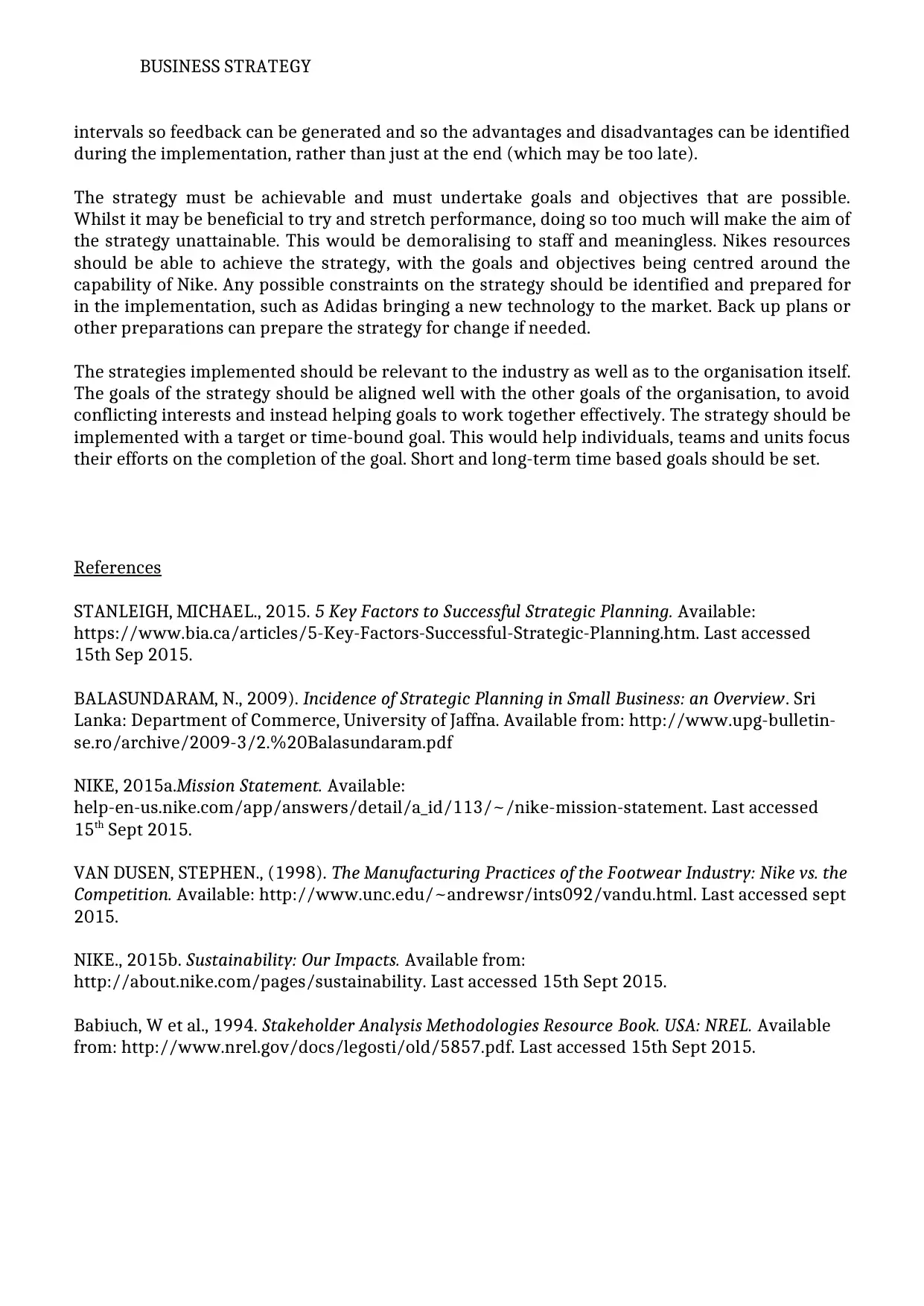
BUSINESS STRATEGY
intervals so feedback can be generated and so the advantages and disadvantages can be identified
during the implementation, rather than just at the end (which may be too late).
The strategy must be achievable and must undertake goals and objectives that are possible.
Whilst it may be beneficial to try and stretch performance, doing so too much will make the aim of
the strategy unattainable. This would be demoralising to staff and meaningless. Nikes resources
should be able to achieve the strategy, with the goals and objectives being centred around the
capability of Nike. Any possible constraints on the strategy should be identified and prepared for
in the implementation, such as Adidas bringing a new technology to the market. Back up plans or
other preparations can prepare the strategy for change if needed.
The strategies implemented should be relevant to the industry as well as to the organisation itself.
The goals of the strategy should be aligned well with the other goals of the organisation, to avoid
conflicting interests and instead helping goals to work together effectively. The strategy should be
implemented with a target or time-bound goal. This would help individuals, teams and units focus
their efforts on the completion of the goal. Short and long-term time based goals should be set.
References
STANLEIGH, MICHAEL., 2015. 5 Key Factors to Successful Strategic Planning. Available:
https://www.bia.ca/articles/5-Key-Factors-Successful-Strategic-Planning.htm. Last accessed
15th Sep 2015.
BALASUNDARAM, N., 2009). Incidence of Strategic Planning in Small Business: an Overview. Sri
Lanka: Department of Commerce, University of Jaffna. Available from: http://www.upg-bulletin-
se.ro/archive/2009-3/2.%20Balasundaram.pdf
NIKE, 2015a.Mission Statement. Available:
help-en-us.nike.com/app/answers/detail/a_id/113/~/nike-mission-statement. Last accessed
15th Sept 2015.
VAN DUSEN, STEPHEN., (1998). The Manufacturing Practices of the Footwear Industry: Nike vs. the
Competition. Available: http://www.unc.edu/~andrewsr/ints092/vandu.html. Last accessed sept
2015.
NIKE., 2015b. Sustainability: Our Impacts. Available from:
http://about.nike.com/pages/sustainability. Last accessed 15th Sept 2015.
Babiuch, W et al., 1994. Stakeholder Analysis Methodologies Resource Book. USA: NREL. Available
from: http://www.nrel.gov/docs/legosti/old/5857.pdf. Last accessed 15th Sept 2015.
intervals so feedback can be generated and so the advantages and disadvantages can be identified
during the implementation, rather than just at the end (which may be too late).
The strategy must be achievable and must undertake goals and objectives that are possible.
Whilst it may be beneficial to try and stretch performance, doing so too much will make the aim of
the strategy unattainable. This would be demoralising to staff and meaningless. Nikes resources
should be able to achieve the strategy, with the goals and objectives being centred around the
capability of Nike. Any possible constraints on the strategy should be identified and prepared for
in the implementation, such as Adidas bringing a new technology to the market. Back up plans or
other preparations can prepare the strategy for change if needed.
The strategies implemented should be relevant to the industry as well as to the organisation itself.
The goals of the strategy should be aligned well with the other goals of the organisation, to avoid
conflicting interests and instead helping goals to work together effectively. The strategy should be
implemented with a target or time-bound goal. This would help individuals, teams and units focus
their efforts on the completion of the goal. Short and long-term time based goals should be set.
References
STANLEIGH, MICHAEL., 2015. 5 Key Factors to Successful Strategic Planning. Available:
https://www.bia.ca/articles/5-Key-Factors-Successful-Strategic-Planning.htm. Last accessed
15th Sep 2015.
BALASUNDARAM, N., 2009). Incidence of Strategic Planning in Small Business: an Overview. Sri
Lanka: Department of Commerce, University of Jaffna. Available from: http://www.upg-bulletin-
se.ro/archive/2009-3/2.%20Balasundaram.pdf
NIKE, 2015a.Mission Statement. Available:
help-en-us.nike.com/app/answers/detail/a_id/113/~/nike-mission-statement. Last accessed
15th Sept 2015.
VAN DUSEN, STEPHEN., (1998). The Manufacturing Practices of the Footwear Industry: Nike vs. the
Competition. Available: http://www.unc.edu/~andrewsr/ints092/vandu.html. Last accessed sept
2015.
NIKE., 2015b. Sustainability: Our Impacts. Available from:
http://about.nike.com/pages/sustainability. Last accessed 15th Sept 2015.
Babiuch, W et al., 1994. Stakeholder Analysis Methodologies Resource Book. USA: NREL. Available
from: http://www.nrel.gov/docs/legosti/old/5857.pdf. Last accessed 15th Sept 2015.
1 out of 8
Related Documents
Your All-in-One AI-Powered Toolkit for Academic Success.
+13062052269
info@desklib.com
Available 24*7 on WhatsApp / Email
![[object Object]](/_next/static/media/star-bottom.7253800d.svg)
Unlock your academic potential
Copyright © 2020–2025 A2Z Services. All Rights Reserved. Developed and managed by ZUCOL.




